Ford Business Model Canvas 2024
With its iconic models like the F-150 pickup and Mustang sports car, Ford has endured over a century as an automotive pioneer while navigating major industry changes, acquisitions, and restructurings. In this Ford business model canvas, we will learn the company’s customer segments, value proposition, revenue streams, channels, customer relationships, key activities, key resources, key partners, and cost structure.
Interesting fact!
In the 1920s, Ford owned hundreds of thousands of acres of rubber plantations in the Amazon rainforest for access to rubber for making tires.
Ford Competitors
GM | Toyota | Honda | Nissan | FCA | Volkswagen | Hyundai | Kia | Tesla | BMW
Customer Segments – Ford Business Model Canvas

Mass Market Consumers: Ford targets mainstream auto buyers seeking affordable, durable vehicles like the Escape SUV, Fusion sedan, and best-selling F-150 truck, which comprised nearly a third of Ford’s 2021 sales.
Fleet Customers: Ford sells hundreds of thousands of vehicles annually to governments, businesses, and rental car companies who value fleet discounts, durability, and maintenance costs.
Luxury Buyers: With brands like Lincoln and previously Jaguar, Land Rover, and Volvo, Ford reaches luxury auto segments through elegant styling, refined interiors, and premium brand prestige.
Performance Enthusiasts: Iconic Ford performance models like the Mustang, F-150 Raptor, and Focus RS appeal to drivers seeking speed, handling, and head-turning styling.
Commercial and Work Customers: Ford’s commercial vans and work-oriented trucks and chassis provide contractors and tradespeople with capable, configurable work vehicles.
Value Proposition – Ford Business Model Canvas
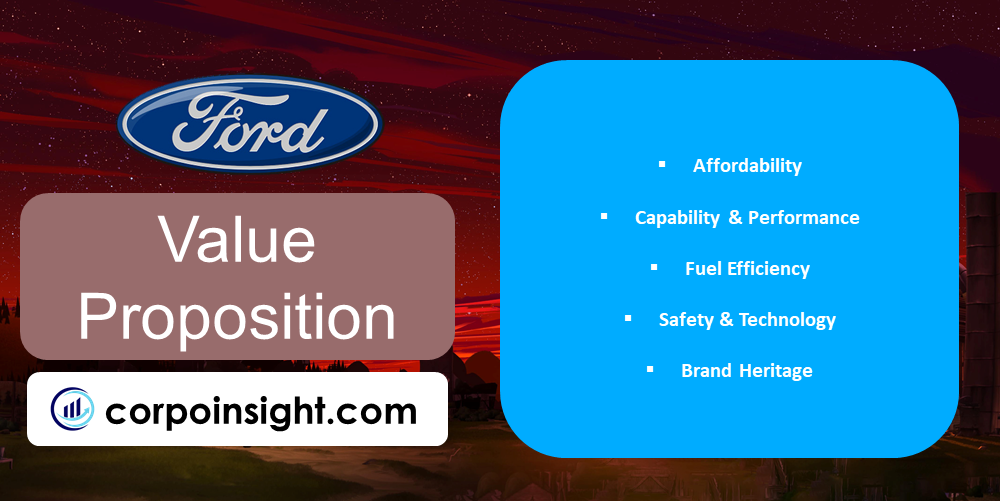
Affordability: Ford’s scale enables competitive pricing across lineups like the economical Focus compact car and practical Escape SUV.
Capability & Performance: Trucks like the best-selling F-150 provide unmatched capability, while Mustang and Focus RS deliver thrilling performance.
Fuel Efficiency: Turbocharged EcoBoost engines, hybrid models like Escape and Fusion, and upcoming EVs promise increased MPGs and low operating costs.
Safety & Technology: Driver-assist features like automatic emergency braking and SYNC infotainment aim to protect and connect occupants through smart design.
Brand Heritage: Ford’s legacy of American manufacturing and iconic models instills owner pride and loyalty spanning generations.
Revenue Streams – Ford Business Model Canvas
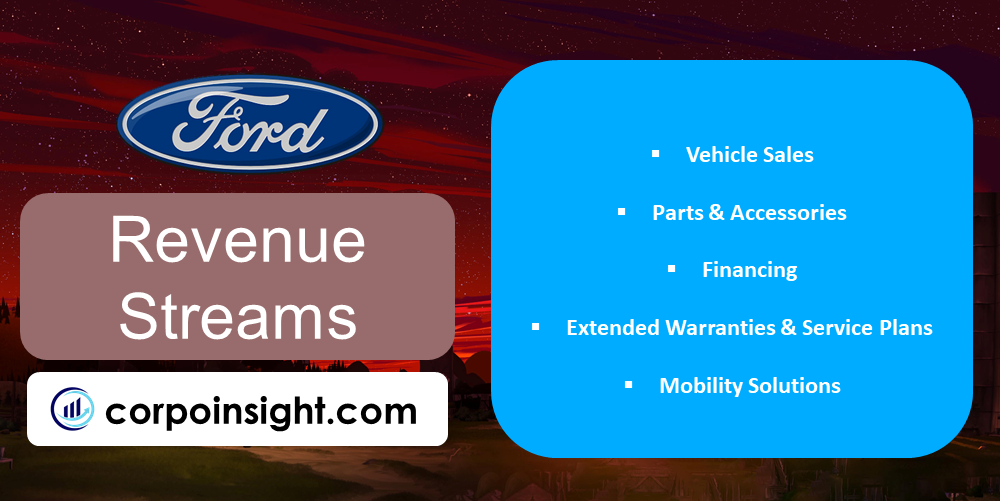
Vehicle Sales: Sales of cars, trucks, SUVs, and commercial vehicles across Ford and Lincoln brands generate the most revenue, recently $136 billion in 2023.
Parts & Accessories: Providing maintenance parts and aftermarket accessories creates a stable revenue stream from Ford’s vast vehicle installed base over time.
Financing: Ford Motor Credit offers attractive financing deals and leasing options to support new and used vehicle purchases and ownership.
Extended Warranties & Service Plans: These high-margin products generate income when customers pay for protection from future repair costs.
Mobility Solutions: Emerging business lines like Ford Smart Mobility provide services related to connectivity, autonomy, and transportation.
Channels – Ford Business Model Canvas
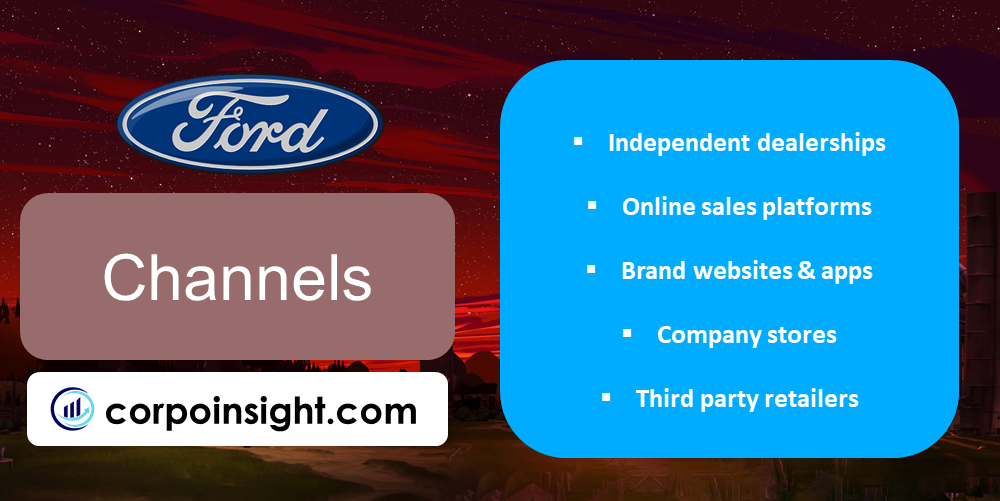
Independent dealerships: The majority of Ford’s are sold through over 2,000 independent, franchised dealers managing sales, pricing, inventory, test drives, and customer relationships locally.
Online sales platforms: Ford has scaled online vehicle browsing, payment, delivery coordination, and subscription models to integrate digital retail channels seamlessly.
Brand websites & apps: Ford and Lincoln branded digital properties allow customers to configure options, view inventory, estimate payments, schedule service, and more.
Company stores: Select urban markets feature Ford-owned stores providing a modern sales experience blended with online conveniences and on-site delivery.
Third-party retailers: Large third-party retailers like Carmax, chains, and used car dealers also distribute significant Ford vehicle volumes in the pre-owned market.
Customer Relationships – Ford Business Model Canvas
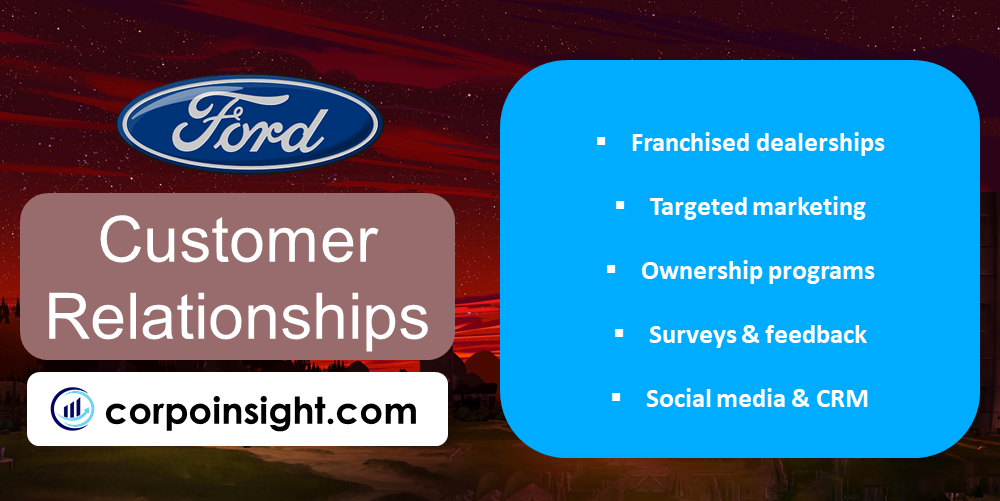
Franchised dealerships: Independent dealerships handle ongoing relationships through maintenance, service, repeat sales, and personal interactions. This limits Ford’s direct customer access.
Targeted marketing: Ford uses data and demographics to tailor advertising and incentives aimed at loyalty and retention among retail and fleet customers.
Ownership programs: Complimentary service pickups, roadside assistance plans, owner events, and membership programs cultivate community and pride.
Surveys & Feedback: Interactions like opinion surveys, focus groups, and customer support channels provide Ford insights on preferences and grievances.
Social media & CRM: Ford monitors customer data and social media interactions to understand emerging issues and identify detractors vs. loyal brand advocates.
Key Activities – Ford Business Model Canvas
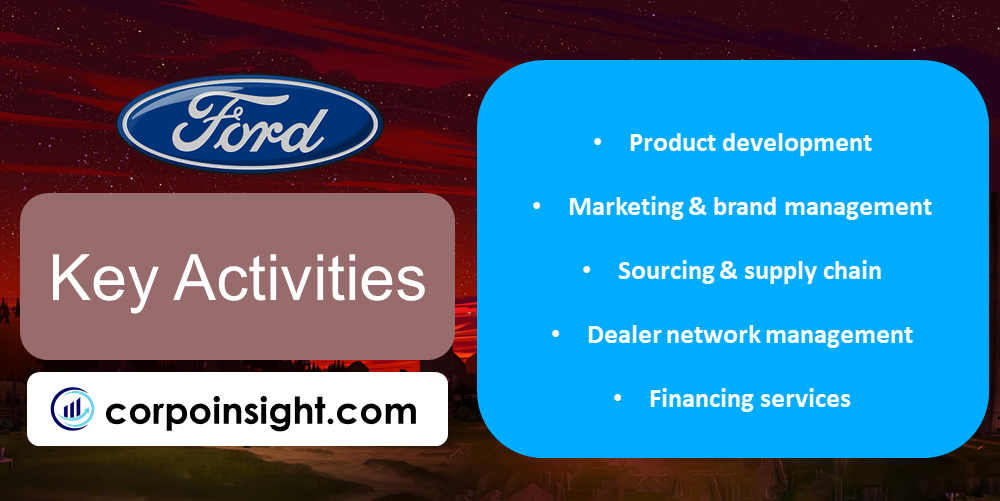
Product development: Ford invests heavily in designing, engineering, prototyping, manufacturing, and assembling cars and trucks customers want at targeted price points.
Marketing & brand management: Advertising, incentive programs, events, and content shape Ford’s brand image and pricing power in diverse global markets.
Sourcing & supply chain: Obtaining raw materials, parts, and systems from reliable, low-cost suppliers ensures efficiency and quality.
Dealer network management: Sales, service, logistics, standards, and relationships across thousands of independent Ford dealers require ongoing attention.
Financing services: Providing competitive customer financing and leasing options to boost affordability requires sophisticated financial operations.
Key Resources – Ford Business Model Canvas

Manufacturing facilities: Ford’s dozens of global factories, assembly plants, and component manufacturing sites compose a massive production system.
Proprietary designs: Valuable patented technologies around drive systems, vehicle platforms, manufacturing processes, and styling offer competitive advantages.
Extensive distribution network: Ford’s established network of independent dealers provides unmatched retail footprint and service capacity.
Raw material partners: Key suppliers delivering steel, aluminum, glass, tires, electronics, and car components enable large-scale auto manufacturing.
Top engineering talent: Ford’s thousands of talented engineers, designers, and vehicle testers refine autos with cutting-edge safety, capability, and technology.
Key Partners – Ford Business Model Canvas

Independent dealerships: Thousands of franchised dealerships provide critical sales, service, marketing, and customer relationship capabilities in local markets.
Suppliers & vendors: Strategic suppliers like Bosch, Continental, and Magna supply complex systems and components at massive scales for cost and quality assurance.
Technology partners: Partners like Google, Amazon, and Apple enable advanced connectivity, entertainment, and drivetrain electrification across models.
Lenders & servicers: Financial partners fund attractive purchase and lease offers to increase customer affordability and capture market share.
Fleet partners: Key corporate, rental, and government fleet partners provide bulk orders, feedback, and cooperative marketing campaigns.
Cost Structure – Ford Business Model Canvas

Materials: Raw materials like steel, aluminum, plastics, and electronics represent a substantial proportion of vehicle production expenses. Efficient sourcing is crucial.
Labor: While significantly automated, final assembly involves considerable labor expense from UAW workers, and union labor agreements impact costs.
Manufacturing overhead: Complex, capital-intensive auto plants have major fixed costs for maintenance, utilities, equipment amortization
Summary of Ford Business Model Canvas

Conclusion on Ford Business Model Canvas
With its massive manufacturing footprint, independent dealer networks, and legacy nameplates like F-Series trucks and Mustang sports cars, Ford has endured for over a century by leveraging scale, brand equity, vertical integration, and continual adaptation to evolve from early automotive pioneer to today’s global mobility solutions provider.

Majoring in marketing from Bangladesh University of Professionals, Sadman Abrar is a learner, obsessed with branding and intrigued to learn about different company strategies, and currently working at bKash.






